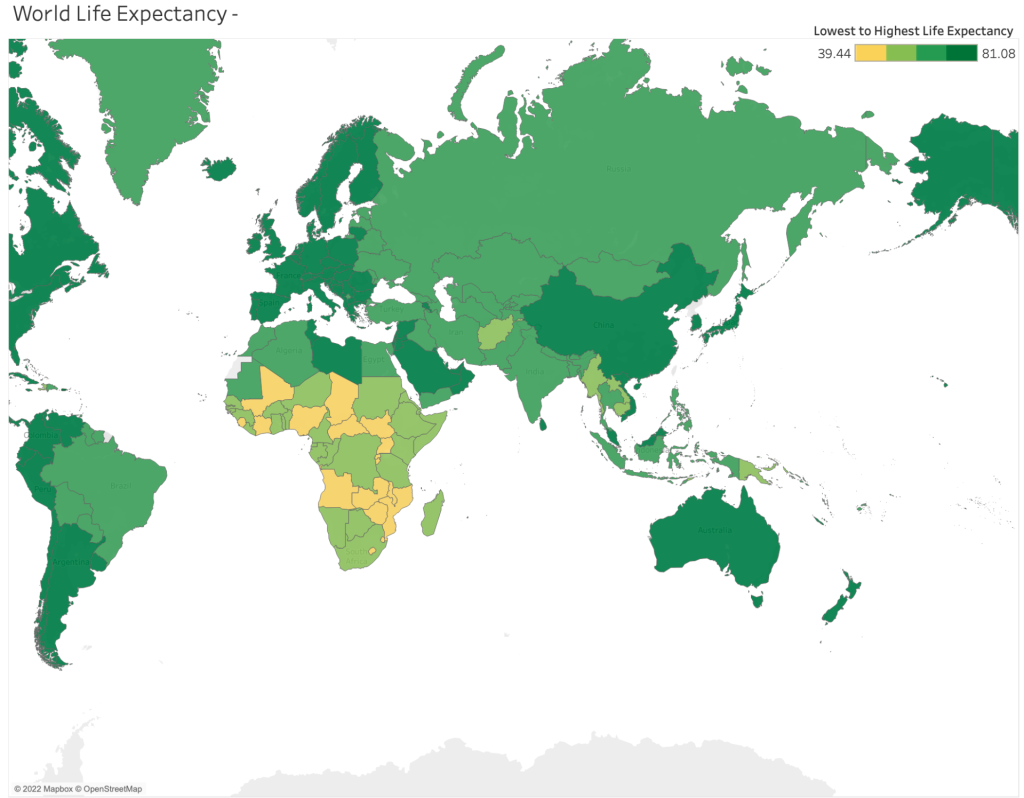
by aia39 | Nov 22, 2022 | Dashboard, Visualization
Ensure healthy lives and promote well-being for all at all ages GOAL:3
On the morning of his 45th birthday, Pedro woke up feeling depressed and anxious what was supposedly a happy occasion was one step closer to inevitable death for Pedro. You see no one in Pedro’s family has ever surpassed the age of 50 to think of it Pedro doesn’t know anyone who has lived above 50 in Mozambique. as Pedro went into the
kitchen to see his three children and wife who had prepared a lovely breakfast for this day. The thought that in a few years he won’t be able to be next to his loved ones ever again broke his heart no father wishes to leave his children.
Mozambique is one of many countries that suffer from low life expectancy at birth due to poor healthcare in the country. Even if the treatment was availableit would be extremely expensive. The average person who lives in Mozambique like Pedro couldn’t afford treatment when needed. All over the country, people are dying early because treatment for simple diseases is not easily accessible.
This tragic occurrence leads to the early death of many people. Like Pedro, there are thousands of people who pray that the government will establish an effective well-trained healthcare system that is also affordable and accessible to everyone in the country.
A proper healthcare system will extend the lives of people like Pedro who wish to stay next to their loved ones for years to come without fear of death at an early age. For a health system to be truly effective it needs to be adequately supervised by the government along hiring trained professionals to ensure the success of the system.
strong regulations and close observation by governments are required so that hospitals and pharmacies don’t take advantage of the people.
If proper healthcare is made accessible to people, health expenditure will increase leading to an increase in life expectancy.
Everyone deserves to live a long healthy life!

In year 2000 we can see that the life expectancy at birth was an average of 48.95 years back then the current health expenditure(%of GDP) was on average 2.26

In year 2019 Mozambique Current health expenditure (%of GDP) became an average of 7.83 and obviously the life expectancy at birth increased to 60.85 years
PROBLEM: The lack of proper healthcare Leeds to Low life expectancy in less developed countries this means that people are dying at early ages Because they do not get access to early diagnosis ,timely treatments and resources to treat the disease.
PROBLEM EVIDENCE :Life expectancy depends on variables that are related to healthcare resources it is obvious That if we look at the current health expenditure(%GDP) that represents the level of resources c
hanneled to health relative uses of the different countries we can see that countries who spend less on health expenditure have a lower life expectancy and vice versa.
POTENTIAL SOLUTION: Proper access to healthcare is associated with lo
w risks of mortality meaning higher life expectancy. Providing access to healthcare and making prices of medication affordable is essential also it is important to focus on patient engagement and connection in order to treat the patient better
SOLUTION DETAILS:Government should work on lowering prices of prescription drugs so that they can be accessible to people who need them. Government must preserve the interests of its citizens by supplem
enting the market where there are gaps and regulate markets to improve efficiency and illuminate any unfairnessin the health sector this will require strong regulations and close observation by governments
SOLUTION VALIDATION:Through the graphs we can see valid evidence that countries that spend more on current healthcare expenditure tend to have higher life expectancy for example In Mozambique in year 2000 we can see that the life expectancy at birth was an average of 48.95 years back then the current health expenditure(%of GDP) was on average 2.26 when the current health expenditure started increasing so did the life expectancy in year 2019 Mozambique Current health expenditure (%of GDP) became an average of 7.83 and obviously the life expectancy at birth increased to 60.85 years meaning that The life expectancy improved 11.9 years this was also the case in a lot of other countries
RECOMMENDATION: For this to be possible it is recommended to recruit train and produce rise health workers because they are the heart of any strong healthcare system also establish affective surveillance on the healthcare industry (pharmacies and hospitals) by improving access to affordable Stable inclusive treatments

by mnb26 | Nov 22, 2022 | Dashboard
The Sustainable Development Goal 3 of the 2030 Agenda for Sustainable Development is to “ensure healthy lives and promoting well-being for all at all ages”.
However, many low- and middle-income countries are having higher mortality rate for infant and lower life expectancy in general compared to other higher income countries.
Infant mortality is the death of young children under the age of one. The infant mortality rate (IMR) is the number of infant deaths for every 1,000 live births.
The first map shows the IMR of most countries around the world. It changes by years. From the map, we can see the global IMR has decreased from 1990 to 2021 and is predicted to continue to decrease in the future However it’s still higher in low-income countries.
Infant Mortality Rate is an important indicator of the overall health of a society. It also reflects the social, economic, and environmental conditions in which children live. There are a number of causes of infant mortality that vary from country to country, including poor sanitation, poor water quality, malnutrition of the mother and infant, and inadequate prenatal and medical care.
Visualizing the data from the World Development Indicators (WDI) throughout different years shows clearly that there is inequality in health, clean resources and vaccination coverage as well.
One of the main reasons for the high IMR is the lack of vaccination, taking Measles as an example, Measles is a highly contagious, serious disease caused by a virus. Before the introduction of measles vaccine in 1963 and widespread vaccination, major epidemics occurred approximately every 2–3 years and measles caused an estimated 2.6 million deaths each year.
More than 140 000 people died from measles in 2018 (over 300 deaths a day) mostly children under the age of 5 years, despite the availability of a safe and effective vaccine.
Due to gaps in vaccination coverage, in high income regions of the world such as Western Europe, measles causes death in about 1 in 5000 cases, but as many as 1 in 100 will die in the poorest regions of the world.
Another important fact to focus on is the Health expenditure per capita which is the amount that each country spends on health, for both individual and collective services.
We notice that the low-income countries have the lowest rate compared the other countries such as US and Finland.
This prevents many women of the low-income countries from getting proper and adequate medical attention due to their inability to afford good care
This is also another reason for the high Infant mortality rate in these countries because they don’t give much importance and budget for the country health system
Recommendation:
There are different causes of infant mortality that vary from country to country, including poor sanitation, poor water quality, malnutrition of the mother and infant, Vaccination and inadequate prenatal and medical care. So, in order to reduce the rate, it’s necessary to enhance the standards of living in these countries on different levels:
- Measles vaccination for children, combined with mass immunisation campaigns in countries with high case and death rates, are key public health strategies to reduce IMR
- Improve life conditions by providing an access to a cleaner food and beverage.
- Increasing the delivery services within health facilities
- Health expenditure need be prioritized by laws: Countries that have prioritized policies on health-care expenditure and have high levels of health spending are those that have succeeded in lowering their infant mortality rates
- Encourage NGOs and the other organization to create projects in these countries for employability purpose and providing solutions to the people’s needs.
Validation
- Monitor the world development indicators (e.g., Infant mortality rate, access to clean food, immunization, GDP,, …) in such countries over the next period and see with how much and how these indicators changed after doing these solutions.
Findings/Recommendation
- Reducing mortality rate may lead to Improving labor supply resulting in improved household income and economic well-being of families and communities.
- Trying to reduce inequality between high- and low-income countries will empower and promote inclusive social and economic growth

by jbe11 | Nov 22, 2022 | Dashboard, Generic, Visualization
The most important statistic for measuring population health is life expectancy. Life expectancy captures mortality across the whole life course, making it more comprehensive than the restricted measure of newborn and child mortality, which concentrates only on mortality at a young age. It provides information on the typical death age for a population.
Since the Age of Enlightenment, life expectancy has rapidly grown. Life expectancy began to rise in the early industrialized nations in the 19th century, but it remained low in the rest of the world. As a result, there was a huge disparity in the distribution of health throughout the world. Good health in the wealthy nations and continuously poor health in the developing nations. This worldwide inequality has declined during the last few decades. The nations with the highest life expectancy in 1800 are the only ones in the world with a lower life expectancy today. Many nations that were formerly afflicted by poor health are quickly catching up.
The world map below shows the life expectancy of the year 2000.

African nations have been struggling with health related issues for quite some time. One of them is that, when compared to other continents, such as Europe Africa has the nations with the lowest life expectancies. Why is that? Does government health expenditure play a big role disaster?
Government health expenditure plays an important role in guaranteeing people’s livelihood and in improving the quality of human capital, and it also plays an important role in affecting economic development.
In order to characterize the specific trend of government health spending affecting life expectancy in Africa, the dashboard below chart shows the expenditure in healthy sectors by the government, from years 2000 to 2018, of the top 3 countries (in terms of life expectancy) and the bottom 3 in comparison as shown in the map.
We clearly see that countries with high government expenditure have a higher life expectancy.
Even though African nations still have a low life expectancy in comparison to other countries, significant improvement has been made since the early 2000s as life expectancy within African nations has seen an increase of at least 10 years.This shows a positive relationship between government health expenditure and life expectancy.
What we can do to further help and develop Africa is to create a funded project by the UN or the WHO to help create more hospitals in the region that would be specialized in treating and aiding people with diseases.





